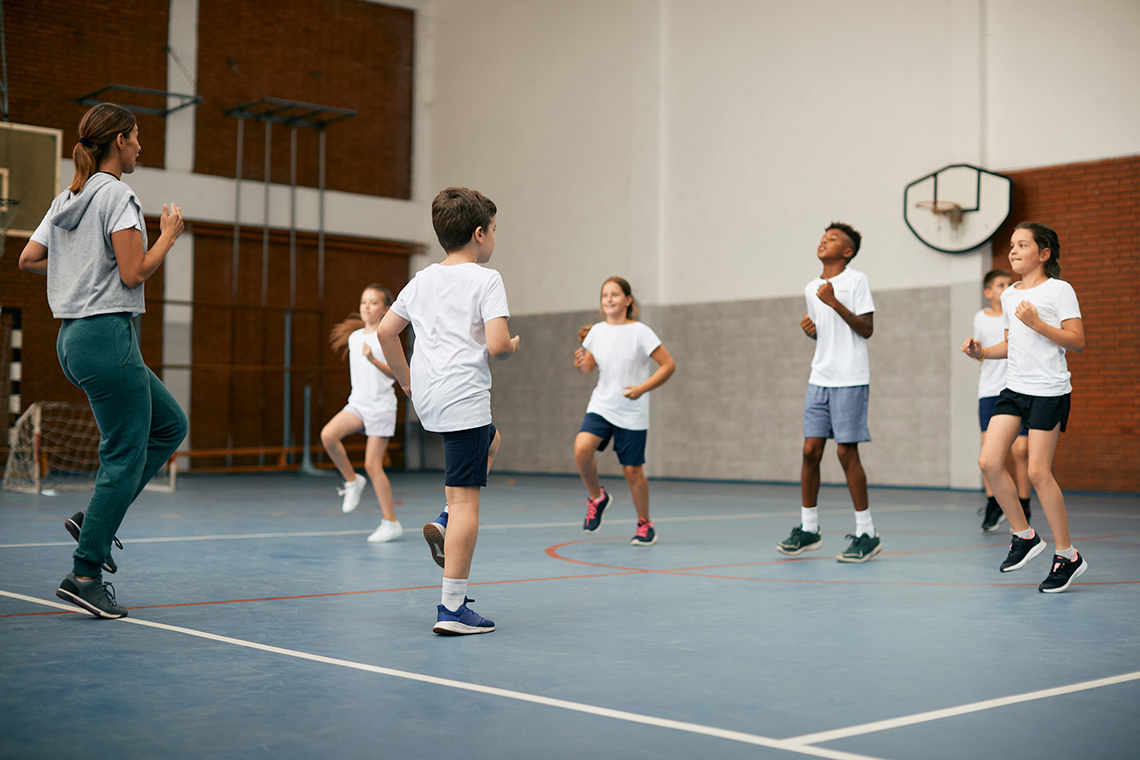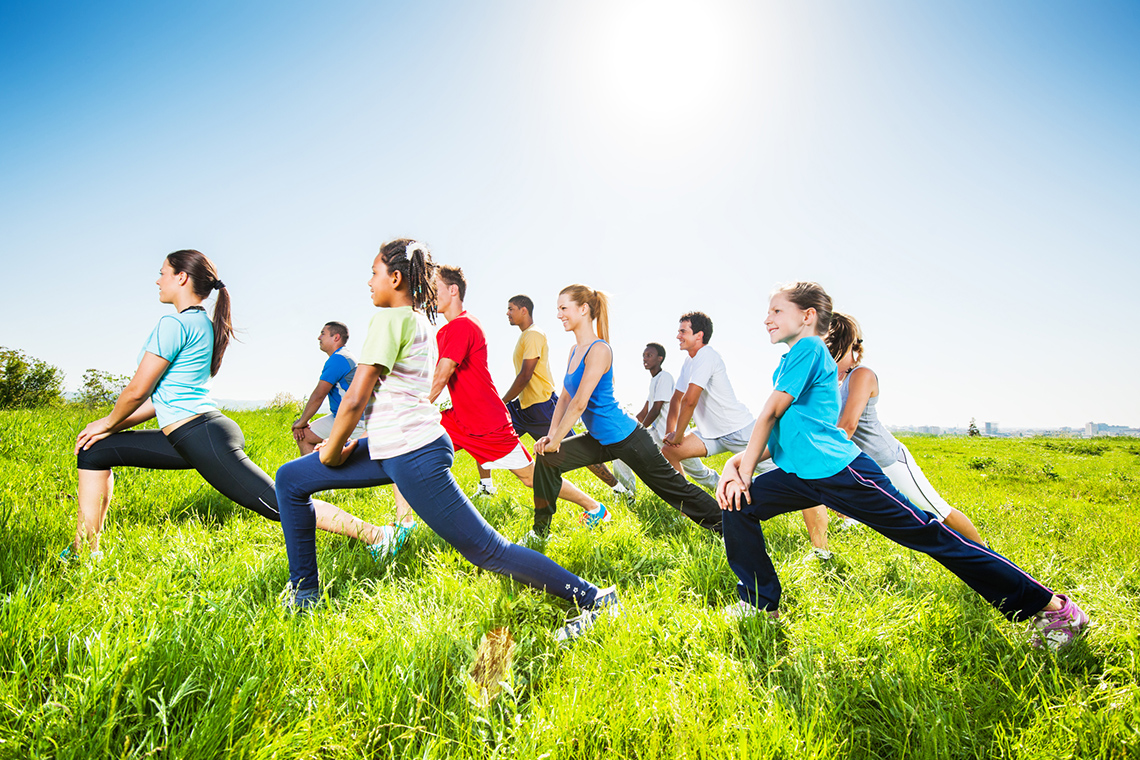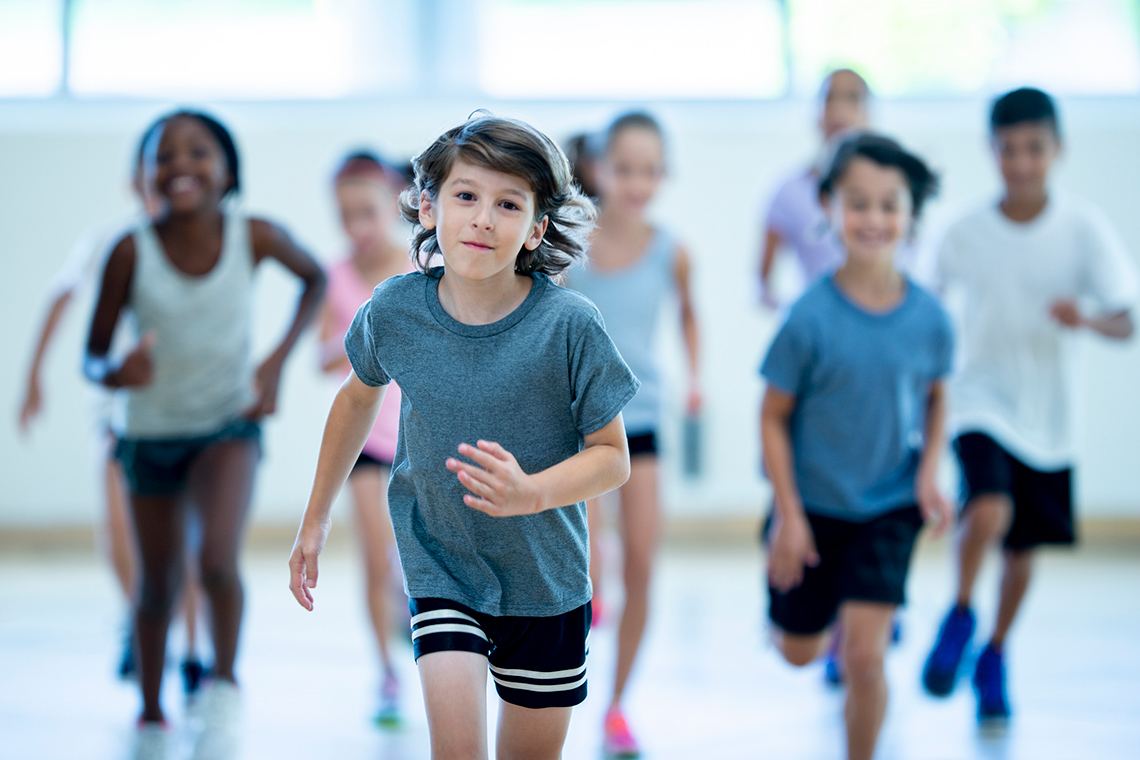Minds On
Before physical activity
What do you know about warming-up before a game or physical activity?
Why is performing a warm-up before a physical activity is important?

Brainstorm
What do you think?
Brainstorm about the following question:
- Why should you perform a warmup before a physical activity?
Record your ideas in a notebook or another method of your choice.
Action
Warm up
It is important to warm up before any physical activity.
A warmup is the act of preparing for a physical activity by mildly exercising and stretching for a short time period beforehand.

The physiological reason to warm up is to protect the muscles and the joints in our body. It also helps to gradually increase the heart rate and blood circulation, which will increase the blood flow to the muscles.
A proper warmup safely prepares the body for the increased demands of physical activity.
Performing a warm-up before any physical activity:
- increases flexibility
- lowers the risk of injury
- increases the range of motion
- causes less muscle tension and pain after the activity is finished
- makes us feel good
Warmups are easy aerobic activities that will gradually elevate the heart rate.
It is also important to cool down after exercising. This gives our muscles a chance to relax and allows the heart to get back to a resting heart rate. And don't forget to hydrate yourself with water!

Always be sure to do your safety checks before you do an activity.
Before you begin, consider these safety precautions:
Safety
Before you begin, consider these safety precautions:
Warm Up
Warm up
Access this video entitled ”Nature 3” to explore a nature themed workout. Try your best to follow along for a quick full-body warmup.
After exploring the warmup, reflect on the following:
- What do you notice about how your muscles feel after the warmup?
- What do you notice about your heart rate after the warmup?
Record your ideas in a notebook or another method of your choice.
Fitness development

Participating in different kinds of activities, such as aerobics, stretching, and strengthening activities, help to develop different parts of fitness:
- cardiorespiratory endurance
- flexibility
- range of motion
Press the following tabs to explore each fitness aspect.

During continuous movement or a physical activity, cardiorespiratory endurance is the heart and lung's ability to deliver oxygen to the working muscles.
This allows us to increase the length, frequency, and intensity of our workouts.

Flexibility is the body's ability to move without pain or stiffness in the body.
We can improve our flexibility by try various stretches for specific muscles in our body.

The range of motion refers to moving our joints through various activities in different directions.
Pause Reflect
Pause and reflect
What are ways you can develop your fitness?
Record your ideas in a notebook or another method of your choice.
Factors
A factor is one thing that causes something to happen or influence a result.
There are many factors that affect our fitness development.
A few factors are:

- heredity
- nutrition
- development stage
- environment
- social and emotional
- mental health
- cultural teachings
Press 'Let's Check!' to access more details about these factors.
- Heredity factors are traits passed on from parents, grandparents, and our ancestors.
- Nutrition refers to the types of food that is eaten.
- Development stages are phases that many children and teens go through as they grow.
- The environment factor is the climate, weather, and temperature where we live in.
- Social and emotional factors are the relationships we have in our lives.
- Mental health refers to how we feel about ourselves.
- Cultural teachings is a factor from our family customs, rituals, and traditions.
During puberty, things about bodies change, like the size and shape. This can also have an effect on a person's energy levels and on their level of participation in fitness activities.
For example:
- How people feel about their bodies can affect the kind of activities they choose to do.
- Having access to safe places to be active outdoors would help us be more active.
- Good nutrition and healthy eating is important for our fitness, as it provides the necessary energy to be active.
Student Success
Think-Pair-Share
If possible, with a partner, discuss one or both of the following scenarios:
Scenario A
Many students of a Grade 7 class are going through puberty. What factors may be affecting their fitness development?
Record your ideas in a notebook or another method of your choice.
Scenario B
Learner A is a runner. Learner A's parent, and their grandparent are also runners. When Learner A was younger, they did not feel like they could also become a runner. But Learner A's family encouraged them, and they are proud of Learner A.
What factors affected Learner A's fitness development as a runner?
Record your ideas in a notebook or another method of your choice.
Note to teachers: See your teacher guide for collaboration tools, ideas and suggestions.
Stretch on!

Stretching before an activity helps the body to prepare itself.
It increases the body temperature and stimulates blood flow throughout the body, so that our tissues will have adequate amounts of oxygen.
It also helps the muscles to loosen up and reduce the risk of an injury.
Dynamic
There are two types of stretches, static and dynamic.
Dynamic stretching is a type of stretching where we are actively moving our joints and muscles for a set of 10 to 12 repetitions, while targeting certain muscle groups.
Dynamic stretching also helps with moving the muscles we are planning to use during a physical activity or a sport we are playing.
To practise our dynamic stretches, choose one or both options if you can!
Remember to perform your safety check before you begin.
Press the following tabs to explore dynamic stretches.
Side shuffle
The side shuffle is a dynamic stretch that can help against groin and outer hip injuries.
Steps:
- Face forward and bend the hips and knees slightly.
- With the bodyweight on the balls of the feet, move a few paces sideways, to the right.
- Then, move back to the left, sideways.
Repeat steps one to three for a set of 10 side shuffles.
It's a challenge!
If you would like to challenge yourself, touch the floor before you change direction (left and right). While moving, keep shoulders pointed forward, so we do not twist our back.
Try this for a set of 10 side shuffles.
Backpedal jog
The backpedal jog is a dynamic stretch that warms up the hips, abs, and the entire body.
Steps:
- Keep the knees and hips bent, with shoulders positioned over the feet.
- Jog or walk backwards with controlled extended strides.
- Bend the elbows to 90 degrees and keep the chest forward while moving backwards.
Move backwards 10 paces, then 10 paces forward. Repeat this for 10 repetitions.

Static
Static stretching is probably the most common type of stretching.
These are stretches where we stand, sit, or lie still and hold a stable position.
Stretching should never hurt. If there is a point in the stretch where it hurts, pull to where it still feels like a stretch, but it can be held comfortably.
These stretches are usually held for 15 to 30 seconds for at least two sets.
Breathe slowly and relax into a stretch, while maintaining a steady breath.
You may choose to do one or as many options as you can to practise our dynamic stretches!
Remember to perform your safety check before you begin.
Press the following tabs to explore static stretches.
Shoulder stretch
The shoulder stretch is a static stretch for the arms, and shoulders.
Steps:
- Reach the right arm straight out to the left.
- Then, bend the left arm and put the left wrist on the back of the right arm, just above the elbow. The left palm will be facing to the side.
- Use the left arm to gently press the right arm across the body until you feel a good stretch.
If possible, hold this pose for 15-30 seconds. Switch arms and repeat steps one to three.

Core twist
Core twist is a stretch for the upper body and abdominal section.
Steps:
- Be seated with the knees bent at 90°.
- In both hands, hold something slightly heavy like a ball, small bag of rice or pasta, or filled water bottles. These are also known as weights.
- Hold the weights in front and turn the upper body to face towards the right.
- Hold this pose for at least 5 seconds, then return to the centre and rest if necessary.
- Then, turn the upper body to face towards the left.
- Hold this pose for at least 5 seconds, then return to the centre and rest if necessary.
If possible, repeat steps one to six for a set of 10.

Pause Reflect
Pause and reflect
After trying the various stretches, let's reflect on the following:
- How did you feel after completing the stretching?
- Did you recognize the signs your body was giving?
- Did you rest when your body needed to?
- What are a few things you can do to develop your personal fitness?
Record your ideas in a notebook or another method of your choice.
Consolidation
Learning check!
Reflect on the following movements. Which stretches are static or dynamic?
For each sentence, select the missing word from the drop-down menu.
Fitness guide

Both static and dynamic stretching promote our healthy fitness habits.
We should always choose a stretch that is comfortable for us, but also be aware of the signs that our body is giving us!
Let's create a fitness guide for a Grade 7 class. The guide will be an appropriate warmup and cool down activity.
Part A: Warmup
The warmup should be a total of 8-10 minutes.
Be sure to include the following:
If possible, try to demonstrate and describe each aerobic exercise and dynamic stretch
Part B: Cool down
The cool down activity should be between 8-10 minutes.
Be sure to include the following:
If possible, try to demonstrate and describe each aerobic movement and static stretches.
Reflection
As you read the following descriptions, select the one that best describes your current understanding of the learning in this activity. Press the corresponding button once you have made your choice.
I feel…
Now, expand on your ideas by recording your thoughts using a voice recorder, speech-to-text, or writing tool.
When you review your notes on this learning activity later, reflect on whether you would select a different description based on your further review of the material in this learning activity.